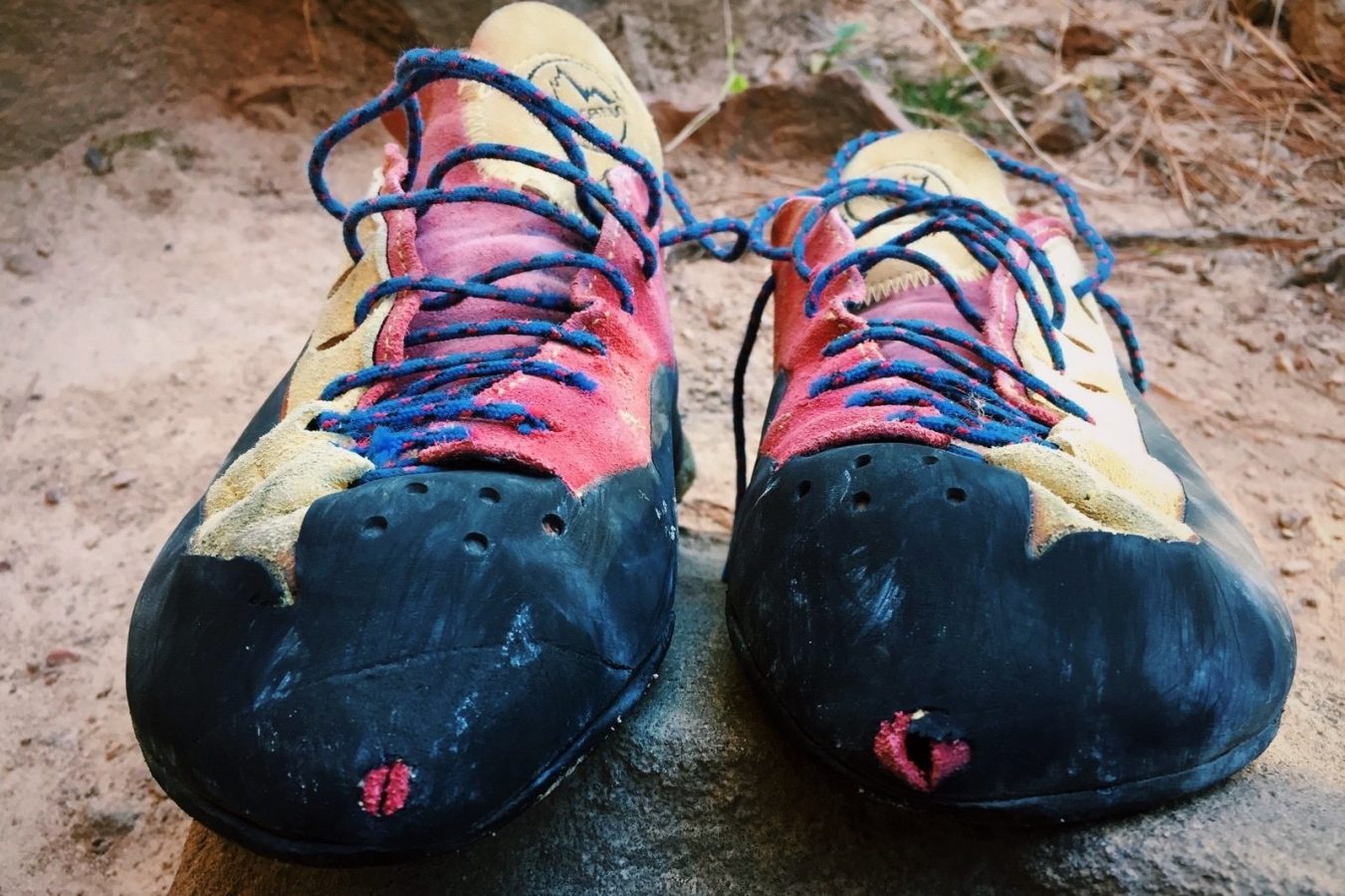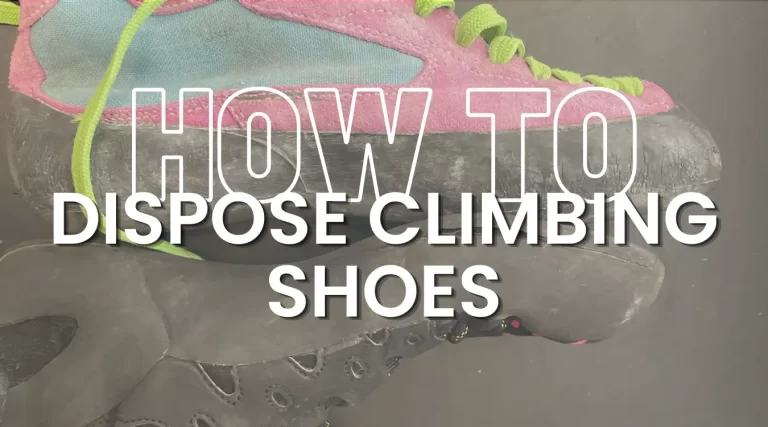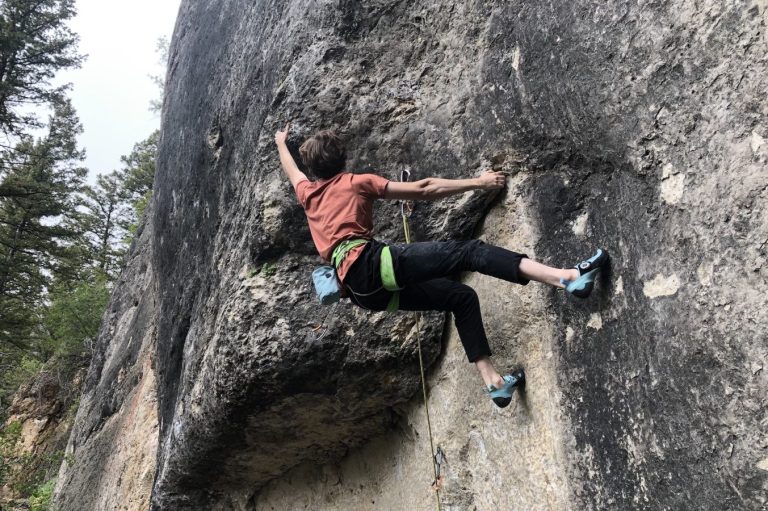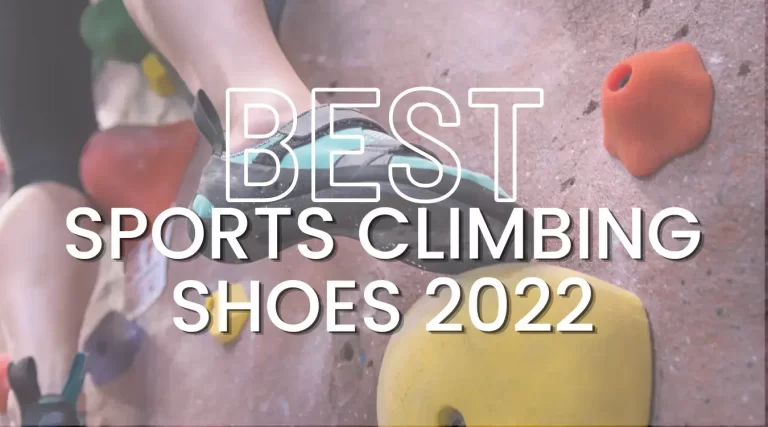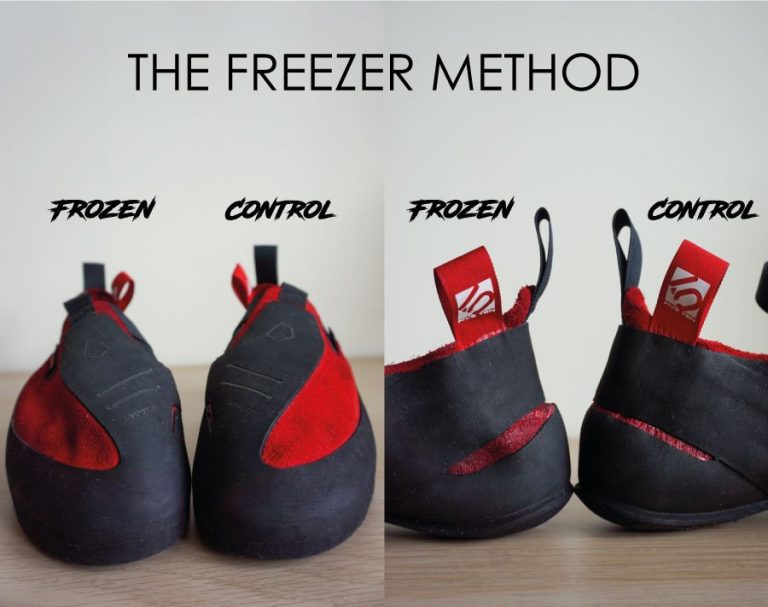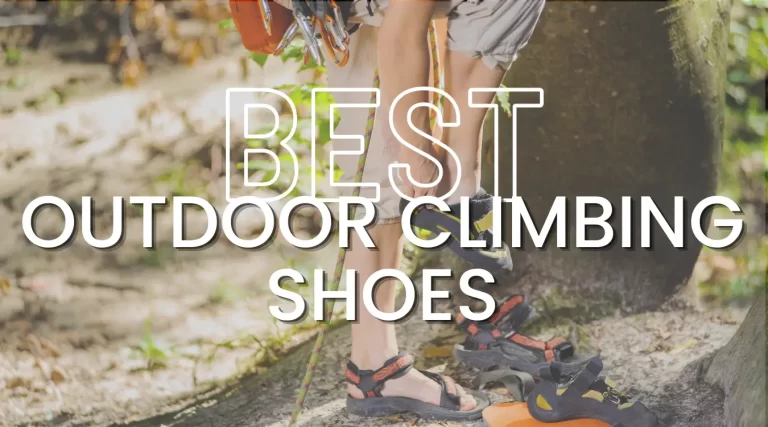Get Max Life and Optimal Performance out of Your Shoes with Timely Resoling and Proper Maintenance
We demand more from our climbing shoes than from any other piece of gear. Rock shoes are safety gear—good footwork coupled with faith in reliable shoes is what keeps us attached to the rock. Sadly, many climbers neglect and disrespect their shoes. Protect yourself by caring for your rock shoes and understanding when it’s appropriate to have them resoled.
When It’s Best to Resole—an FAQ
Only a few climbers (most sponsored) retire shoes after they burn through the factory sole. The rest of us have our shoes resoled, which at $42 to $66 a pop is much cheaper than buying a new pair. There are, however, a few things to know both about resoling and extending your shoes’ life span such that they remain good candidates for repeated resoles. Eric Pauwels opened the Boulder, Colorado, resoling outfit Rock & Resole in 1989 and has since slapped new soles on untold thousands of shoes. He and fellow cobbler Colby Rickard, who with his partner, Sally Gilman, took over the business after Pauwels retired, have gleaned tips from the “bootload” of footwear that’s passed through their shop, presented here as an FAQ:
When do I need resoles?
Pauwels says that 90 percent of sole wear takes place in the big-toe area, so that should be where you evaluate rubber thickness when deciding to resole. “Keep in mind that you start with a four-millimeter sole there, and it will gradually decrease to the point where it’s paper thin,” says Pauwels. “At that point you want to resole.” Climbers often make the mistake of looking at general sole condition or the outside of the shoe, but the big toe (our foot’s power point) invariably wears thin first.
Do I need toe caps?
Toe caps are patches of sticky rubber used to repair holes in the rand, the thinner (two-millimeter) band of rubber that wraps laterally around a shoe’s upper. Your resoler might replace the full rand or just cut away a small crescent-shaped swatch and glue on new rand rubber. If your rand has a visible hole in it, you need a toe cap, but you might also need a toe cap absent a hole, as a rand can develop weaknesses around the toe box, depending on wear patterns. (Maybe you are a “toe dragger” or do lots of gym climbing where you stab at sharp little jibs.)
To inspect a rand that’s not visibly holey:
- Start by the pinkie toe, which generally has the least amount of rand wear, and pinch the rand with your thumb, working toward the big toe.
- With this perspective of a full-thickness rand, inspect for areas of reduced resistance; they can be focused like a pinhead or as large as a pencil eraser.
- Pay particular attention to rand wear on shoes that have stiff (plastic) midsoles, as these tend to spread your feet outward and create pressure against the outside of the shoe.
- Point out any trouble spots to your resoler, and ask about a toe cap. Note that getting a toe cap will also mean getting a new half-sole: You have to remove the old sole to put on the toe cap because rand rubber wraps a quarter inch around beneath the outsole. In a perfect world, you’ll time needing a toe cap with needing a new sole.
What if I’ve punched through the suede or synthetic upper?
Are your shoes kaput? Not necessarily. Cobblers can layer a netting or mesh fabric to repair these sorts of holes and firm up the upper, including in high-impact areas like the toe box. Even if you’ve punched a hole through your rand and upper, your shoes might be salvageable. A cobbler can mend smaller holes with a leather patch and then overlay new rubber.
How many times can I resole my shoes?
Pauwels says that a looked-after pair of performance shoes, without any rotting or deterioration in the footbed and midsole, and with the uppers and closure system still intact, should stand up well to resoling three or four times. After that, the shoes generally won’t hold their shape. “If you’re climbing moderate slabs up the Flatirons, you might get a dozen,” says Pauwels. “But if you’re crack climbing, you might get two.”
What do I do with old shoes I can’t use anymore?
If your shoes are so beat up that you can’t use them, chances are no one else wants them either. Pauwels says it’s best to just throw them away—there is limited demand for recycled rubber, and the rubber from climbing shoes represents such a small fraction of this that the shoes usually end up in the landfill anyway.
Shoe-Care Do’s
- Keep your entire shoe clean. You can safely machine-wash rock shoes a few times over their life span, to keep dirt from building up throughout the shoe and contributing to deterioration. Use cold water and a delicate cycle, and then air-dry the shoes.
- Use a liquid urethane rubber, such as Freesole Urethane Formula Shoe Repair, for field repairs like emergency bonding or patching. (Pauwels recommends against Shoe Goo, which is a contact adhesive.) You can also use Freesole or Five Ten’s Stealth Paint to coat and reinforce high-impact points on the shoe, such as those that wear out crack climbing like the cinching buckles on velcro closures.
- Keep your soles clean and grit free to prolong the life of the rubber. Wipe them down with water, saliva, or rubbing alcohol; put them on, and then place a towel, crashpad, or flat rock in the dirt below the climb so that the rubber stays clean as you step onto the rock. You can also wipe your sole down on your opposite pant leg as a final gesture.
- Keep your feet clean at the cliff, or clean them before you put on your rock shoes. Dirt, grime, and bacteria lead to odor and decay issues. A few baby wipes go a long way, and you can even scrub your nasty old dogs in the shower with an antibacterial soap and burly brush after climbing.
Shoe-Care Dont’s
- Dry your shoes with talcum powder. Rickard says that it can migrate throughout a shoe and infiltrate between the midsole and the sole, compromising the bond between sole and shoe. Neither does he recommend fabric-softener sheets, whose oils and scent chemicals likewise permeate the shoe—so deeply that he’s been able to smell the perfume in the rubber when grinding off old soles. For odor issues caused by bacteria, it’s best to simply air-dry your kicks before trying other measures.
- Leave your shoes out in excessive heat (130 degrees Fahrenheit or hotter), such as in the direct sun in your car on a hot day—it leads to delamination. According to Pauwels, the glues that hold soles on are very heat sensitive. In fact, “If you want to loosen up a glue bond, you apply heat,” he says.
- Wear your shoes while not climbing. Approaching climbs in performance shoes or wearing them to belay will break down the midsole until your shoe loses it shape and supportive foundation.
- Taking the shoes half off and standing on the heels while you belay will further deform them. If you don’t like fussing with approach or tennis shoes between climbs, bring flip-flops or slip-on shoes.
Odor Eaters: Kill the Stank
If air-drying isn’t working and your shoes are still boggy and rancid, try the following (with the caveat that these tips might shorten your shoes’ life span):
- Put coffee beans, cat litter, or baking soda in a sock, and place it in your shoes when not wearing them.
- Freeze your shoes to kill the bacteria.
- Stuff crumpled-up newspaper in your footbed.
- Use a scrub brush and a mild detergent to wash the funk out of the footbed.
Tommy Caldwell on the Life Span of Performance Shoes
Professional climber Tommy Caldwell demands a lot from his rock shoes, putting them through their paces on thin, technical Yosemite Valley granite where matchstick-sized holds might be considered jugs. For his 2008 in-a-day redpoint of El Capitan’s 2800-foot 5.13d/5.14a Magic Mushroom, Caldwell even stashed a fresh, just-broken-in pair of boots 18 pitches up, before the crux, flared chimneys on which he estimates he applied 250 pounds of force to his feet. These rigors demanded a fresh, stiff midsole; the pair he’d worn to that point were too broken down. For supertechnical slab and thin-face climbing, Caldwell thinks shoes are best after a one-pitch break-in, assuming you don’t wear them too tight, and will hold their performance edge for around 20 pitches of highly technical climbing. After that, he reserves those shoes for easier climbs.
When evaluating whether to retire or resole a performance shoe, look for:
- Rounding of the toe, with the seam between the rand and outsole becoming blurred and indistinct. By comparison, this transition will be quite apparent on fresh, brand-new shoes.
- Mushiness in the sole. While wearing his shoes, Caldwell says, “If I can take one finger and press it through the sole and feel my finger pushing up into my foot, it means the midsole is broken down too much and it won’t be great for super-hard pitches.”
- Integrity of the big-toe area. With your shoe off, if you can press into the sole and make a serious dent in the big-toe focal point, the shoe has likely outlived its useful span.
In conclusion, taking care of your climbing shoes is essential for both safety and performance. Regular maintenance, timely resoling, and proper cleaning can extend the life of your shoes and ensure they continue to provide the grip and support you need on the rock. By following the tips and advice provided in this article, you can maximize the lifespan of your climbing shoes and get the most out of your investment.
FAQs
- How often should I resole my climbing shoes? The frequency of resoling depends on your climbing style and the condition of your shoes. On average, you can resole them three to four times if well-maintained.
- What are toe caps, and when do I need them? Toe caps are rubber patches used to repair holes in the rand of your shoes. You need them when your rand has visible holes or weak spots.
- Can I repair shoes with punched-through uppers? Yes, cobblers can repair shoes with punched-through uppers by layering mesh fabric and overlaying new rubber.
- How should I prevent shoe odor? To prevent shoe odor, keep your shoes clean, dry them thoroughly, and use odor-fighting methods like coffee beans or freezing.
- When is it time to retire climbing shoes? Consider retiring climbing shoes when the toe area is rounded, the sole feels mushy, or there is significant damage to the big-toe area, impacting performance and safety.
